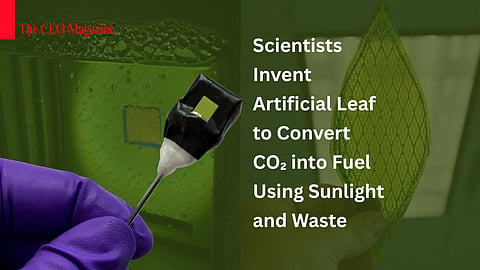
- News
- Women
- Magazine
- IndustryIndustry
- InsightsInsights
- Success Stories
- PublishPublish
- ContactContact
- Media KitMedia Kit

Scientists Invent Artificial Leaf to Convert CO₂ into Fuel Using Sunlight and Waste
As climate change and pollution accelerate, scientists are looking to nature for solutions. In a remarkable breakthrough, researchers have developed an artificial leaf that replicates photosynthesis to convert carbon dioxide (CO₂) into clean fuel, using sunlight and industrial waste as key ingredients.
Unlike a real leaf, this artificial version is a cutting-edge device made of advanced materials. It uses perovskite, a highly efficient solar energy absorber, which captures sunlight similarly to how plants use chlorophyll.
On its surface are tiny copper structures known as copper nanoflowers. These act as catalysts, speeding up chemical reactions that transform CO₂ into valuable hydrocarbons such as ethane and ethylene—important components for natural gas and various industrial products.
One major challenge in artificial photosynthesis has been the high energy needed to split water molecules for hydrogen, a step crucial for making hydrocarbons. The new technology bypasses this by using glycerol, a waste byproduct from biodiesel manufacturing, instead of water.
This not only cuts the energy requirements drastically—by as much as 200 times compared to previous designs—but also turns waste into a useful resource, increasing the overall sustainability of the process.
Beyond producing fuel, the artificial leaf generates chemicals like glycerate, lactate, and formate. These substances are valuable for pharmaceutical and cosmetic industries, indicating that the technology could revolutionize chemical manufacturing alongside energy production.
While promising, the current system converts only about 10% of CO₂ into desired hydrocarbons, with the rest forming other byproducts. Scientists are focusing on enhancing the selectivity and efficiency of the copper nanoflowers to improve yields.
Scaling from lab prototypes to industrial applications will require further development, investment, and testing. The cost-effectiveness and integration with existing infrastructure will also determine the speed of adoption.
Imagine a future where factories and power plants use artificial leaves to capture their carbon emissions and convert them into clean fuels and useful chemicals using sunlight. This could significantly reduce the reliance on fossil fuels and help tackle global warming.
Though still in early stages, this innovation offers a glimpse into a sustainable, circular economy where carbon is reused instead of released—paving the way for greener industries and a healthier planet.
Follow us on Google News
